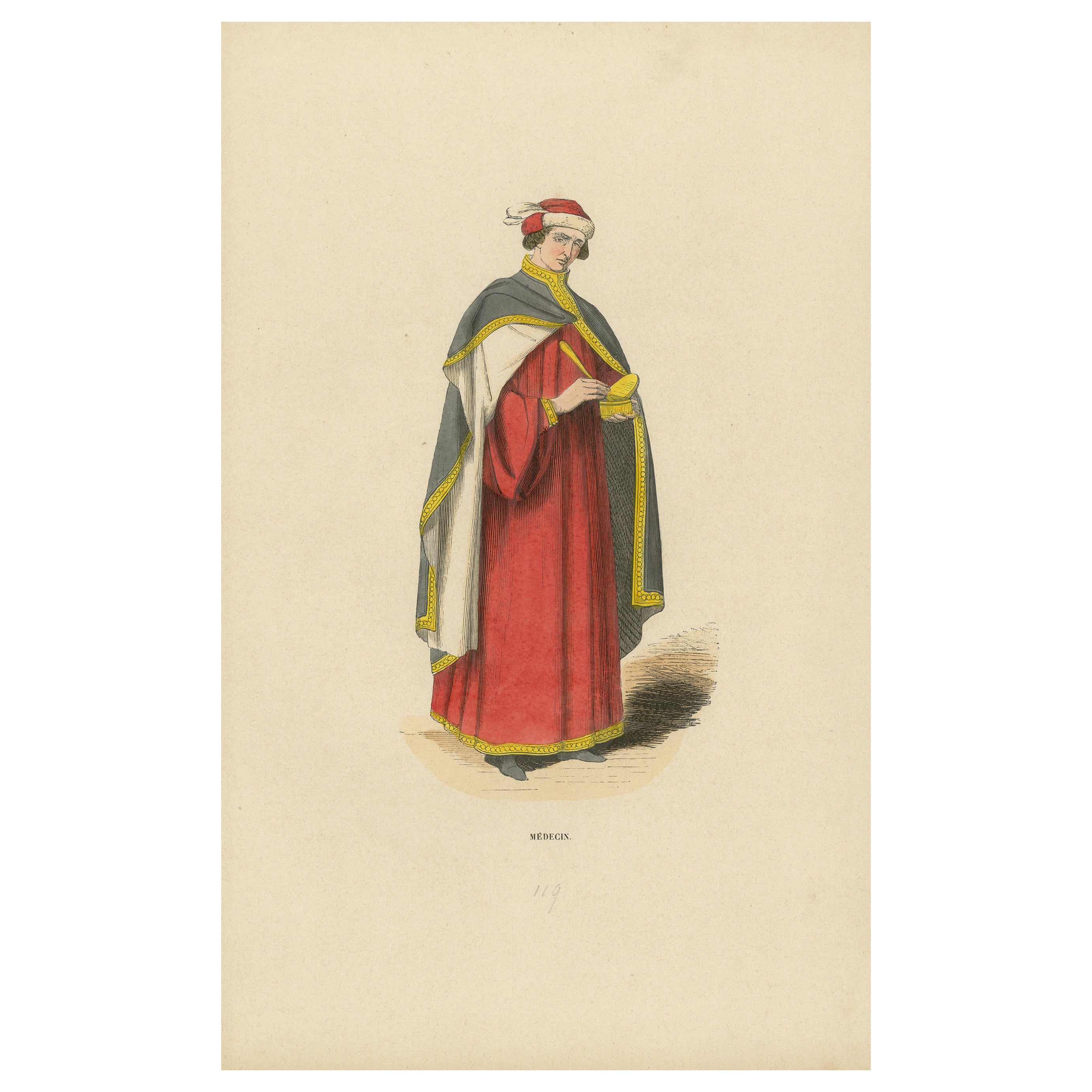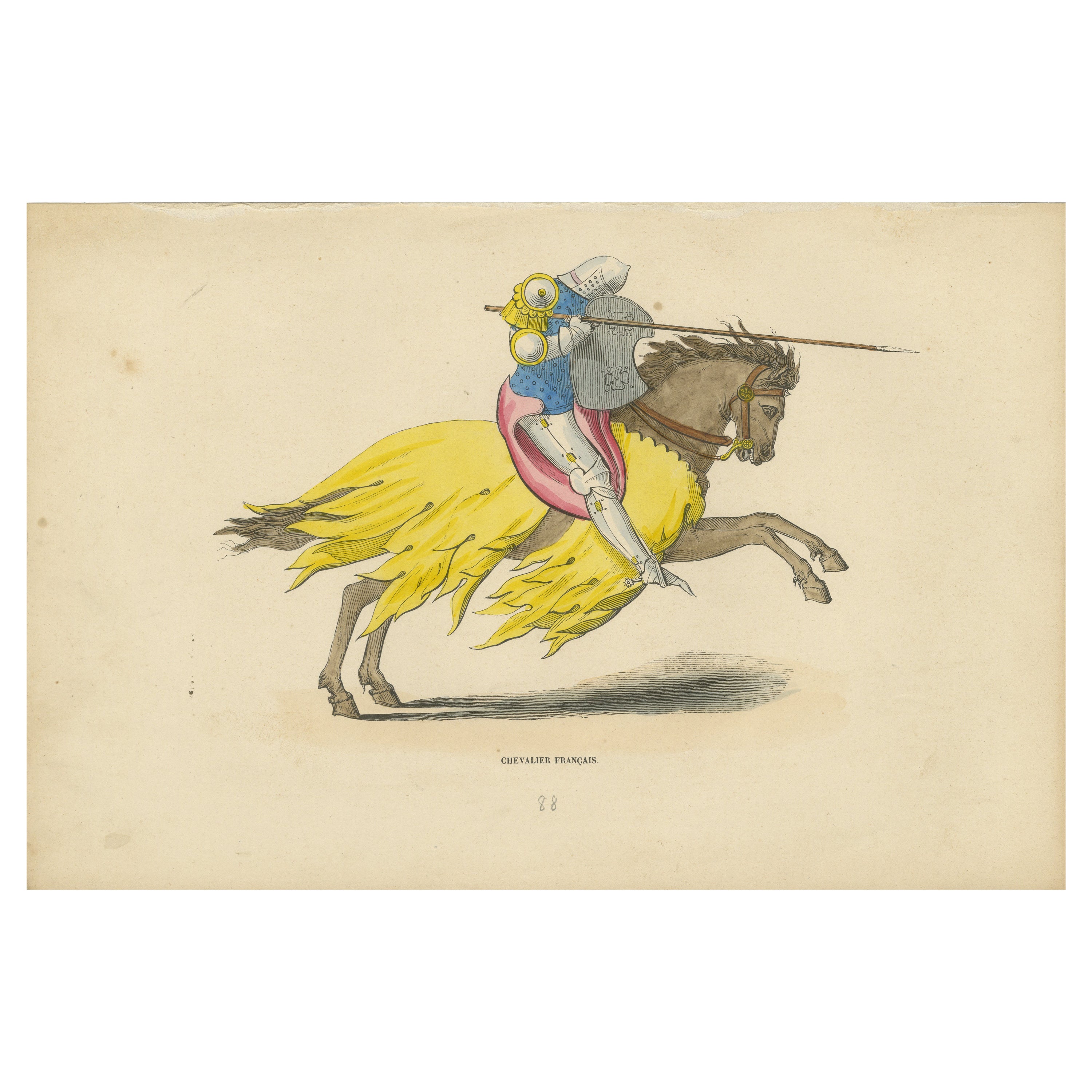Items Similar to Toil of the Ages: Medieval Peasantry at Work, 1847
Want more images or videos?
Request additional images or videos from the seller
1 of 6
Toil of the Ages: Medieval Peasantry at Work, 1847
About the Item
The image depicts two medieval peasants, as indicated by the caption "Paysans," which is French for "Peasants".
The figure on the left is wearing a simple tunic with leggings and a red Phrygian-style cap, which was often associated with liberty and the common people in various periods of European history. He carries an axe over his shoulder and has a pouch attached to his belt, suggesting that he might be a woodsman or involved in some form of manual labor.
The figure on the right, also in modest attire, wears a cloak with a hood, possibly indicating a lower-class status or the necessity of work outdoors. He holds a spade, indicating agricultural work, which was the most common occupation for peasants during the Middle Ages.
Their clothes appear to be practical and robust, meant for work rather than display. The image captures the essence of the peasantry's daily life in the Middle Ages, which was marked by hard labor and simple living conditions.
The colors have a nice glow over them. Historically, egg whites, known as glair, and sometimes egg yolk were indeed used in illumination and painting, particularly in manuscripts, to give colors a brighter appearance and to add a sheen or gloss to the work. This technique was quite common during the Middle Ages and into the Renaissance.
Egg whites can be applied as a varnish over pigments to enhance their brightness and to protect the colors. This application could make the colors appear more vivid and also add a slight glossy sheen to the surface of the image.
Egg yolk, on the other hand, was commonly used as a binding agent in paint. It forms the basis of tempera paint, a medium that was widely used before the advent of oil painting. Egg yolk helps to create a durable and long-lasting color that adheres well to various surfaces.
In the context of the print from 1847, it's less likely that egg whites or yolks were used directly on the print, as by that time, commercial printing processes would have been more advanced and less reliant on such manual methods. However, if this print is a representation of an earlier style or is meant to mimic the appearance of hand-painted manuscripts, the original artists might have employed techniques or materials that gave a similar effect to those achieved with egg-based binders and varnishes.
- Dimensions:Height: 10.63 in (27 cm)Width: 7.09 in (18 cm)Depth: 0 in (0.02 mm)
- Materials and Techniques:
- Period:
- Date of Manufacture:1847
- Condition:Good. Overal very light toning and light soiling but the image itself clean and hand-colored almost 200 years ago and still in expliciet colors. Aged paper with typically warm, yellowish-brown hue, mostly around the edges. Study the image carefully.
- Seller Location:Langweer, NL
- Reference Number:
About the Seller
5.0
Platinum Seller
These expertly vetted sellers are 1stDibs' most experienced sellers and are rated highest by our customers.
Established in 2009
1stDibs seller since 2017
1,932 sales on 1stDibs
Typical response time: <1 hour
- ShippingRetrieving quote...Ships From: Langweer, Netherlands
- Return PolicyA return for this item may be initiated within 14 days of delivery.
More From This SellerView All
- Attire of a Medieval Scholar: The Learned Physician of the Middle Ages, 1847Located in Langweer, NLTitle: "Attire of a Medieval Scholar: The Learned Physician of the Middle Ages" This hand-colored lithograph, titled "Médecin" in the original French, is a detailed portrayal of a m...Category
Antique 1840s Prints
MaterialsPaper
- Jongleur of the Medieval Times: A Musician's Craft in the Middle Ages, 1847Located in Langweer, NLThis hand-colored engraving, titled "Jongleur," portrays a medieval entertainer, a precursor to modern-day musicians and performers. The term "jongleur" denotes a versatile artist commonly seen in medieval courts and public spaces, engaging audiences with music, poetry, and storytelling. In this print, the jongleur is shown playing a flute-like instrument, focused intently on his performance. His attire is strikingly colored, with a blue tunic that falls above the knee, allowing for ease of movement during his performance. The tunic is cinched at the waist by a darker belt, which helps to secure his garment during his active profession. Over his shoulders, he wears a red cape, which may symbolize his role as an entertainer, often brightly dressed to stand out in a crowd. He wears tight red hose, a common element of medieval clothing...Category
Antique 1840s Prints
MaterialsPaper
- Scholar of the Arts: The Medieval Academic, 1847Located in Langweer, NLTitle: "Scholar of the Arts: The Medieval Academic" Description: This print illustrates a learned individual, likely a doctor of the arts or a scholar, from the medieval period. The...Category
Antique 1840s Prints
MaterialsPaper
- Engraving of a Guardian of the Fort: The Medieval Arbaletrier, 1847Located in Langweer, NLThe image is labeled "Arbaletrier," which is French for crossbowman. It depicts a medieval soldier equipped for battle. The crossbowman is dressed in a pink tunic with a blue collar...Category
Antique 1840s Prints
MaterialsPaper
- Charge of Valor: The Medieval French Knight, 1847Located in Langweer, NLTitle: "Charge of Valor: The Medieval French Knight" Description: This vibrant antique print captures the dynamic energy of a French knight in full gallop. ...Category
Antique 1840s Prints
MaterialsPaper
- Scholar of the Codex: A Medieval Jurist in Study, 1847Located in Langweer, NLThe image depicts a person labeled "Docteur des Lois," which translates to "Doctor of Laws." This term historically refers to an individual who has achieved advanced scholarly status in the field of law, equivalent to the modern term "Juris Doctor." The figure is seated at a lectern, deeply engrossed in a large book, which likely represents legal texts or scholarly works. The individual is attired in a robe with a fur-lined cape, suggesting a status of academic or professional distinction. The robe is red, a color often associated with higher education and learning. The headwear appears to be a type of turban, which was a common academic regalia in certain cultures and times. The setting and attire suggest that this person is a scholar or a high-ranking legal professional, possibly a university professor or a magistrate from the medieval or Renaissance period. Egg whites can be applied as a varnish over pigments to enhance their brightness and to protect the colors. This application could make the colors appear more vivid and also add a slight glossy sheen to the surface of the image. Egg yolk, on the other hand, was commonly used as a binding agent in paint. It forms the basis of tempera paint, a medium that was widely used before the advent of oil painting. Egg yolk helps to create a durable and long-lasting color that adheres well to various surfaces. In the context of the print from 1847, it's less likely that egg whites or yolks were used directly on the print, as by that time, commercial printing processes would have been more advanced and less reliant on such manual methods. However, if this print is a representation of an earlier style or is meant to mimic the appearance of hand-painted...Category
Antique 1840s Prints
MaterialsPaper
You May Also Like
- Original Antique Print of Deer, 1847 'Unframed'Located in St Annes, LancashireGreat image of deer. Unframed. It gives you the option of perhaps making a set up using your own choice of frames. Lithograph after Cpt. brown with original hand color. Published:...Category
Antique 1840s English Folk Art Prints
MaterialsPaper
- 19C Aquatint Engraving of the Quay at WaterfordLocated in Dallas, TXPresenting a lovely 19C Aquatint Engraving of the Quay at Waterford in Waterford city in Ireland. This engraving has been hand embellished with aquatint color(s) and is from Ireland circa 1820-40. It features a scene of the Quay or Port of Waterford from circa 1820. We are basing this upon the attire of the figures in the engraving and the tall ships. It features Reginald’s Tower (still located at the Waterford Quay to this day). Georgian Quay buildings, a number of moored tall ships and row boats, barrels, horses and carts, women and British soldiers. The engraving was professionally reframed and matted in Dallas in the 1980’s and the rear of the frame says that it was “Museum Mounted and Matted”. The frame has a lovely Grecian pattern around the front. If you are Irish...Category
Antique Mid-19th Century Irish George III Prints
MaterialsPaper
- Original Antique Print of a Hoopoe, 1847, UnframedLocated in St Annes, LancashireGreat image of a hoopoe. Unframed. It gives you the option of perhaps making a set up using your own choice of frames. Lithograph after Cpt. Brown with original hand color. Publis...Category
Antique 1840s English Folk Art Prints
MaterialsPaper
- Original Antique Print of a Racehorse, 1847 'Unframed'Located in St Annes, LancashireGreat image of a racehorse. Unframed. It gives you the option of perhaps making a set up using your own choice of frames. Lithograph after George Stubbs with original hand color. ...Category
Antique 1840s English Folk Art Prints
MaterialsPaper
- Original Antique Print of Monkeys, 1847 'Unframed'Located in St Annes, LancashireGreat image of monkeys. Unframed. It gives you the option of perhaps making a set up using your own choice of frames. Lithograph after Cpt. Brown with original hand color. Publish...Category
Antique 1840s English Folk Art Prints
MaterialsPaper
- Original Antique Print of A Bat, 1847 'Unframed'Located in St Annes, LancashireGreat image of a bat. Unframed. It gives you the option of perhaps making a set up using your own choice of frames. Lithograph after Cpt. brown with original hand color. Published...Category
Antique 1840s English Folk Art Prints
MaterialsPaper





